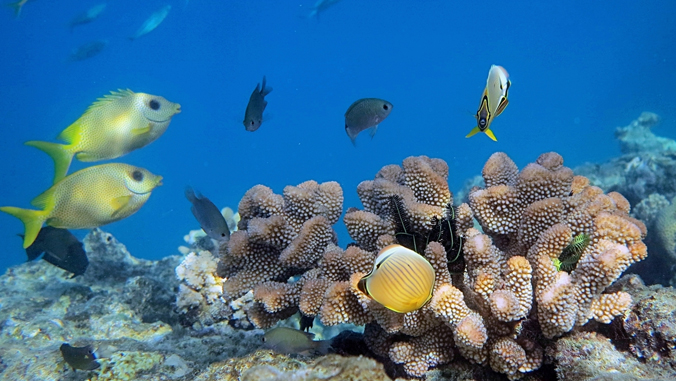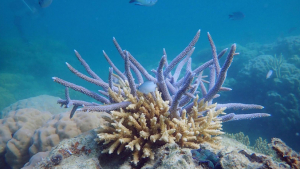Hedging Bets To Restore Coral Reef Health
Resource managers and conservationists have been offered an innovative, new approach to selecting coral species for reef restoration
 (Photo credit: Damaris Torres-Pulliz) In a study published in Journal of Applied Ecology, an international team of scientists, led by a University of Hawaiʻi at Mānoa researcher, revealed a strategy for choosing a set of key coral species that will best maintain ecosystem functions critical for reef health.
(Photo credit: Damaris Torres-Pulliz) In a study published in Journal of Applied Ecology, an international team of scientists, led by a University of Hawaiʻi at Mānoa researcher, revealed a strategy for choosing a set of key coral species that will best maintain ecosystem functions critical for reef health.
 (Photo credit: Damaris Torres-Pulliz)
(Photo credit: Damaris Torres-Pulliz)
“The ecosystem services that coral reefs provide for people, such as coastal protection and fisheries, depend upon coral species with a broad range of what are called life history strategies, for example slow to fast growing, mounding to branching shapes, and under to upper storey,” said Joshua Madin, study lead author and research professor at the Hawaiʻi Institute of Marine Biology in the UH Mānoa School of Ocean and Earth Science and Technology (SOEST). “Therefore, restoration practitioners need to consider this range of local species when restoring coral reefs—much like forest restoration requires more than just fast-growing plants.”
Read more about UH research on coral reefs
The scientists worked together to develop this approach during a workshop organized by the University of Melbourne (U Melbourne) and the Australian Institute of Marine Science (AIMS).
Coral reefs worldwide are rapidly disappearing due to a number of anthropogenic disturbances, with global warming being the biggest threat. In response, coral reef restoration is a growing research field and industry. Most coral reefs comprise tens to hundreds of stony coral species, yet resources for coral reef restoration are insufficient to restore them all. Methods for selecting species that will best maintain species diversity and ecosystem function are currently unavailable.
The research team combined databases of coral species traits with their ecological characteristics, including their resistance to thermal bleaching, to see how best to select sets of species for restoration using a hedging approach, much like that used for investment portfolios.
“Selection based on ecological characteristics is important for hedging against future species loss, whereas trait diversity is important for hedging against the loss of certain ecosystem services, reef-building groups, life history categories and evolutionary variety,” said Madin.
Aiding restoration practitioners
This hedging approach provides a simple framework for aiding restoration practitioners in selecting target species for their projects, depending on spatial scale and resources.
“For example, if a program only has funds to focus on 20 coral species, they would want to focus on the sets of species to get the most ecosystem bang for their buck,” said Professor Madeleine van Oppen from U Melbourne and AIMS, who is the senior author on the paper. “Current coral restoration programs tend to focus on easy to collect, ‘weedy’ coral species, which have similar characteristics and cannot support ecosystem services on their own.”
The study also found that, if species data are limited, selecting species at random is much better than selecting species that are easy to collect. The extra effort required will pay off in terms of preserving ecosystem services that communities rely on. The method can be applied to any coral reef for which coral trait data are available.
As coral reefs face greater risks, including in Hawaiʻi and Australia, where people depend on reefs for tourism, recreation, coastal protection and sustenance, coral restoration is the focus of much research and development. The new approach to selecting coral species is already being applied to a hybrid reef program in Hawaiʻi funded by the Defense Advanced Research Projects Agency. The goal of that groundbreaking project is to create an engineered structure that provides habitat for corals and other reef life while protecting coastlines from flooding, erosion and storm damage.
–By Marcie Grabowski
Publication: Joshua S. Madin, et al. Selecting coral species for reef restoration. Journal of Applied Ecology, (2023). DOI: 10.1111/1365-2664.14447
Original Story Source: University of Hawaii at Manoa

 Alerts Sign-up
Alerts Sign-up